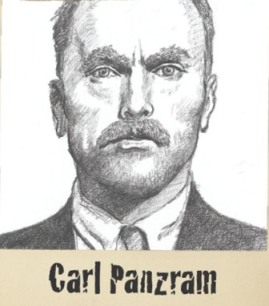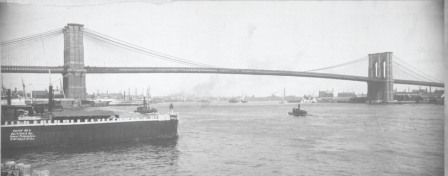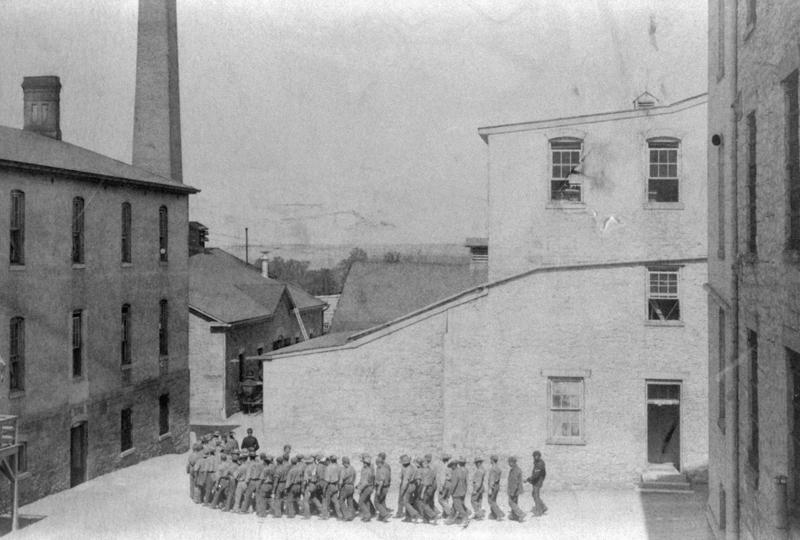BORN FOR THE GALLOWS

Name: Carl Panzram
DOB: 28 June 1891
Profession: Professional thief and lifelong jailbird
Upbringing: Brought up on a farm; father left home when he was 7; became an alcoholic in his teens; hopped a train and ran away from home at 14
Description: Killer and rapist
Convictions: Sent off to reform school by his family at the age of 11; served time in nine states, including Sing Sing prison (NY)
Number of victims: 22
As the moment of his execution approached, when serial killer Carl Panzram was asked whether he had any last words, he is reported to have turned to his executioner and said: ‘Hurry it up, you Hoosier bastard! I could kill ten men while you’re fooling around!’ It was probably not much of an exaggeration.
Much of what we know about Panzram comes from his autobiography, published 40 years after his death. It is a well-written and articulate account of his life; not at all what one would expect from someone with limited formal education. The man who would come to murder dozens was born to a Prussian immigrant couple on 28 June 1891 on a Minnesota farm near the Canadian border. He and his six siblings were raised in poverty, a situation made worse when his father deserted the family. This shameful act took place when Carl Panzram was 7 years old. A year later the boy was arrested for the very adult crime of being drunk and disorderly. He was soon committing burglary, and at the age of 11 was sent to the Minnesota State Training School, a reform institution. Panzram’s claims, made late in life, that he was beaten and sexually abused, are probably true. That he also committed his first murder there, the victim being a 12-year-old boy, has not been verified. In July 1905, he burnt one of the school’s buildings to the ground. Evidently, he wasn’t a suspect in the destruction, as he was released just a few months later.

Making up for a childhood of deprivation, Panzram later fenced goods on the Lower East Side, NY and bought himself a yacht on the proceeds
Murder in mind
He enrolled in another school, but was soon in conflict with one of the teachers. The dispute was elevated to such a point that Panzram brought a handgun to class, intending to murder the instructor in front of his fellow students. The scheme collapsed when the gun fell to the floor during a struggle. He left the school and the family farm, and started ‘riding the rails’. Any feeling of freedom the 14-year-old might have felt in this transient lifestyle probably came to an end when he was gang-raped by four men. For the rest of his 39 years, Panzram was enraged by the pain and humiliation he had suffered through the incident. As part of some warped idea of revenge, he went on to forcibly sodomize more than a thousand boys and men.
Any feeling of freedom the 14-year-old Panzram might have felt probably came to an end when he was gang-raped by four men. As revenge, he went on to sodomize more than 1,000 boys and men
Mere months after having left the Minnesota State Training School, Panzram was again in reform school, again for having committed burglary.
He soon escaped with another inmate named Jimmie Benson. They remained together for a time, moving around the American Midwest, causing havoc, burgling houses and stealing from churches before setting them on fire.
After they split up, Panzram joined the United States Army. It was a strange choice of profession, one for which he was ill suited. During his brief stint in service, he was charged with insubordination, jailed numerous times for petty offences and, ultimately, was found guilty on three counts of larceny. Panzram received a dishonourable discharge and on 20 April 1908 was sentenced to three years of hard labour at the United States Disciplinary Barracks at Fort Leavenworth in Kansas.
In prison, the 16-year-old Panzram was beaten and chained to a 50-pound metal ball which he was made to carry. He dreamed of escape, but found it impossible. It was only after serving his three-year sentence that he finally got out. Panzram returned to his old transient lifestyle, moving through Kansas, Texas, California, Oregon, Washington, Utah and Idaho. He committed burglary, arson, robbery and rape. In his autobiography, Panzram writes that he spent all his spare change on bullets and for fun would take shots at farmers’ windows and livestock.
In prison, the 16-year-old Panzram was beaten and chained to a 50-pound metal ball which he was made to carry. He dreamed of escape, but found it impossible…
Another story involves a railway policeman whom Panzram raped at gunpoint. He forced two hobos to witness the act and then recreate it themselves.
He was arrested many times and served a number of sentences under a variety of assumed names. After his second incarceration and escape from Oregon State Prison, Panzram made his way to the east coast. Ending up in New Haven, Connecticut in the summer of 1920, Panzram burgled the home of former United States president William H. Taft, the man who had once signed the paper sentencing him to three years in prison at Fort Leavenworth.

Prisoners at Fort Leavenworth Penitentiary where Panzram served time
The haul from the Taft mansion far exceeded previous burglaries. After fencing the goods in Manhattan’s Lower East Side, Panzram bought a yacht. He then sailed the East River, breaking into the yachts of the wealthy moored along his route. He took to hiring unemployed sailors as deckhands. In the evenings, he would drug his crew, sodomize them, shoot each in the head with a pistol stolen from the Taft house and throw their bodies overboard. After about three weeks, Panzram’s routine came to an end when his yacht was caught in an August gale and sank. He swam to shore with two sailors, whom he never saw again.

In Angola, Panzram shot six guides and fed them to crocodiles
Heart of darkness
Following a six-month sentence for burglary and possession of a loaded gun, Panzram stowed away on a ship bound for Angola. While in the employ of the Sinclair Oil Company he sodomized and murdered a young boy. He later hired six locals to act as guides and assist in a crocodile-hunting expedition. Once downriver, with crocodiles in sight, he shot all six and fed the men to the beasts. After travelling along the Congo River and robbing farmers on the Gold Coast, he made his way back across the Atlantic.
Following his return to the United States, Panzram continued where he left off, committing robbery, burglary and sodomy. These ‘routine’ crimes were punctuated by the murders of three boys; each was raped before being killed.
On 26 August 1923, Panzram broke into the Larchmont, New York, train depot and was going through the stored baggage when he was confronted by a policeman. He was sentenced to five years in prison, most of which was served at Clinton Prison in upstate New York. True to character, Panzram made no attempt to become a model prisoner. During his first months at Clinton he tried to firebomb the workshops, clubbed one of the guards on the back of the head and, of course, attempted to escape. This final act had consequences with which he would struggle for the rest of his life.
The incident began when Panzram failed in his attempt to climb a prison wall. He fell nearly 30 ft (10 m), landing on a concrete step. Though his ankles and legs were broken and his spine severely injured, he received no medical attention for 14 months. The months of agony Panzram endured intensified his hatred and he began to draw up elaborate plans to kill on a mass scale. One scheme involved blowing up a railway tunnel, then releasing poison gas into the area of the wreck.
During his first months at Clinton he tried to firebomb the workshops, clubbed one of the guards on the back of the head and, of course, attempted to escape
Standing before his new warden on that first day, Panzram warned, ‘I’ll kill the first man that bothers me’
One-man crime wave
When he was finally released from Clinton, in July 1928, Panzram emerged a crippled man. However, his diminished capacity did nothing to prevent his return to crime. During the first two weeks of freedom, he averaged approximately one burglary each day. More seriously, on 26 July 1928, he strangled a man during a robbery in Philadelphia. By August, Panzram was again in custody. Perhaps realizing that he would never again leave prison, he confessed to 22 murders, including those of two of the three boys in the summer of 1923.
On 12 November, he went on trial for burglary and housebreaking. Acting in his own defence, he used the courtroom as a stage from which to scare the jury and threaten witnesses. By the end of the day he had been found guilty on all counts and was sentenced to a total of 25 years in prison.
On 1 February 1929, he arrived at the United States Penitentiary at Leavenworth, Kansas. It was an area of the country he knew well; 20 years earlier he had served time at the nearby military prison. Standing before his new warden on that first day, Panzram warned, ‘I’ll kill the first man that bothers me.’
True to his word, on 20 June 1929, Panzram took an iron bar and brought it down with force on the head of Robert Warnke, his supervisor in the prison laundry. When the other prisoners attempted to escape, Panzram began chasing them around the room, breaking bones.
He was tried for Warnke’s murder on 14 April 1930. Again, he undertook his own defence, smugly challenging the prosecutor to find him guilty. It wasn’t a difficult challenge. When the judge sentenced Panzram to hang, he was threatened by the condemned man.
On 5 September 1930, Panzram was hanged. Many organizations had worked to prevent the execution, much to Panzram’s annoyance. Nine months before his death, he wrote to one such organization, the Society for the Abolishment of Capital Punishment: ‘The only thanks you and your kind will ever get from me for your efforts on my behalf is that I wish you all had one neck and that I had my hands on it.’
Danger signs: As a teenager, committed arson and fantasized about mass murder
Pattern of crime: Trapped in a vicious circle of committing violent crime and being imprisoned; his passion was to see churches burn
Breakthrough: Captured during a break-in
Last words: [to his executioner] ‘Hurry it up, you Hoosier bastard! I could kill ten men while you’re fooling around!’
Sentence: The death penalty